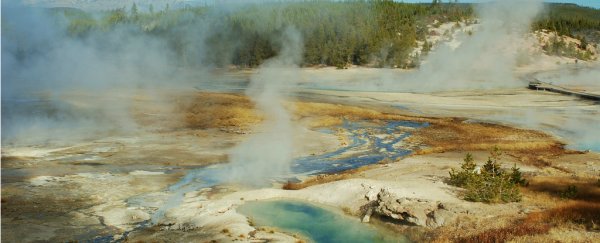A man who died at Yellowstone National Park back in June was completely dissolved in acidic water after trying to 'hot pot' - or soak himself - in the waters of one of the park's hot springs, an official report has concluded.
Until now, the brutal details of the 23-year-old's death had remained unclear. All that had been reported was that he fell into one of the springs in the Norris Geyser Basin on a Tuesday evening, and by Wednesday, there was nothing left of his body. It had entirely melted away.
"In a very short order, there was a significant amount of dissolving," Lorant Veress, the deputy chief ranger of Yellowstone, told local news station KULR.
The official report on Colin Scott's death was recently released following a Freedom of Information Act request filed by KULR.
The investigation revealed that Colin and his sister Sable Scott were looking for a place to 'hot pot' in the steaming waters of the Norris Geyser Basin back in June - an incredibly dangerous practice that's explicitly forbidden in the park.
Colin left the safety of the park's boardwalk and approached a hot spring, before reaching down to check the temperature of the water with his hand.
According to Sable, as he bent down, he slipped and fell into the pool, which just so happens to contain not only some of the hottest waters in the park, but also the most acidic.
Search and rescue rangers were called out immediately when they saw Colin's body in the pool, along with his wallet and flip flops, but they couldn't recover his remains because a lightning storm set in.
The next day, there was nothing left - his body and personal belongings had completely dissolved. The water was described as "churning and acidic".
Some parts of the report were censored before being release, out of respect for the victim's family, including both a video and a description of it.
At least 22 people are known to have died from hot spring-related injuries in and around Yellowstone National Park since 1890.
So why are Yellowstone's waters so dangerous? The park is set on top of a geologically active supervolcano, with magma bubbling below the surface and heating up a range of geysers and hot springs in the area.
These waters are hot enough to regularly burn and scald visitors who stray off the path, but out of all the park's geysers, the hottest are found in the Norris Geyser basin, which is located on the intersection of three major faults.
The water here can get up to a scalding 121 degrees Celsius (250 degrees Fahrenheit) - but that's not the only danger they pose.
Unlike the rest of the alkaline water in the park, the water in the Norris Geyser basin is highly acidic, as a result of the chemicals spewed out by hydrothermal vents.
The Echinus Geyser in the basin, for example, has a pH of around 3.5. For perspective, 0.1 M Hydrochloric acid, the dilution that's often used in labs, has a pH of 1, and pure water has a pH of 7.
Somehow these waters still host a range of extremophiles - bacteria that thrive in the toxic water - which give the water its unique milky colour.
But the conditions are deadly for humans - not only will the water cause severe and potentially fatal burns on contact, it will also rapidly begin to break down human flesh and even bone.
So take this as a warning - even if you think you're 'tough' enough to ignore the warning signs and dip your toe into one of Yellowstone's bubbling thermal pools, it's not worth the risk.
After all, we can't forget this is one of the most geologically active places on Earth.
"It is wild and it hasn't been overly altered by people to make things a whole lot safer, it's got dangers," said Veress. "And a place like Yellowstone which is set aside because of the incredible geothermal resources that are here, all the more so."
A team of researchers has just started a new project mapping what lurks beneath the giant supervolcano, so we can better predict the risk the park poses and learn more about the unique ecosystem.
But in the meantime, stay on the path.
